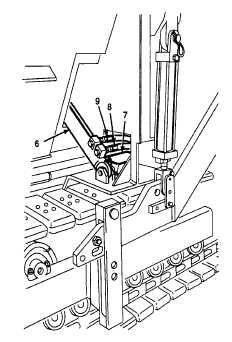TM 5-3895-373-20
15.6.
REPLACE HOPPER LIFT CYLINDER - Continued
A.
REMOVE - Continued.
The hopper wing weighs 875 lbs (397
kg). Ensure hoist and slings are in
good working condition and have
adequate lifting capacity to support
hopper wing. Failure to use adequate
lifting
equipment
may
result
in
serious injury or death.
e.
Using the hoist, raise hopper wing as needed to
provide access to hopper lift cylinder (6).
2.
DISCONNECT
HOPPER
LIFT
CYLINDER
HOSES.
Cleaning solvent, P-D-680, is TOXIC
and flammable. Wear protective
goggles and gloves. Use only in a
well ventilated area. Avoid contact
with skin, eyes, and clothes, and do
not breathe vapors. Keep away from
heat or flame. Never smoke when
using solvent; the flashpoint for Type
III cleaning solvent is 2000F (93,30C).
Failure to do so may result in injury
or death to personnel.
If personnel become dizzy while
using cleaning solvent, immediately
get fresh air and medical help. If
solvent contacts skin or clothes,
flush with cold water. If solvent
contacts eyes, flush eyes with water
and get immediate medical attention.
Thoroughly clean hoses and fittings
before disconnecting. Always plug
or cap off disconnected fittings to
prevent intrusion of contaminants.
Failure to properly clean and cap off
connectors may result in system
contamination
and
equipment
damage.
a.
Use cleaning cloth moistened with cleaning
solvent to clean all dust, dirt, and oil or grease
residue from hose ends and fittings at hopper lift
cylinder (6).
b.
Tag lower cylinder hose "inlet" and upper hose
"outlet".
c.
Place drip pan (7) below hydraulic hoses (8 and
9).
Hydraulic
oil
can
be
moderately
flammable and can be an irritant to
the
skin,
eyes,
and
respiratory
system. Avoid prolonged exposure.
Eye protection and rubber gloves
must be worn when working with
hydraulic oil.
d.
Disconnect hydraulic hoses (8 and 9) from
hopper lift cylinder. Drain hydraulic oil from
hoses into drip pan. Dispose of waste hydraulic
oil in accordance with local procedures.
GO TO NEXT PAGE
15-50

